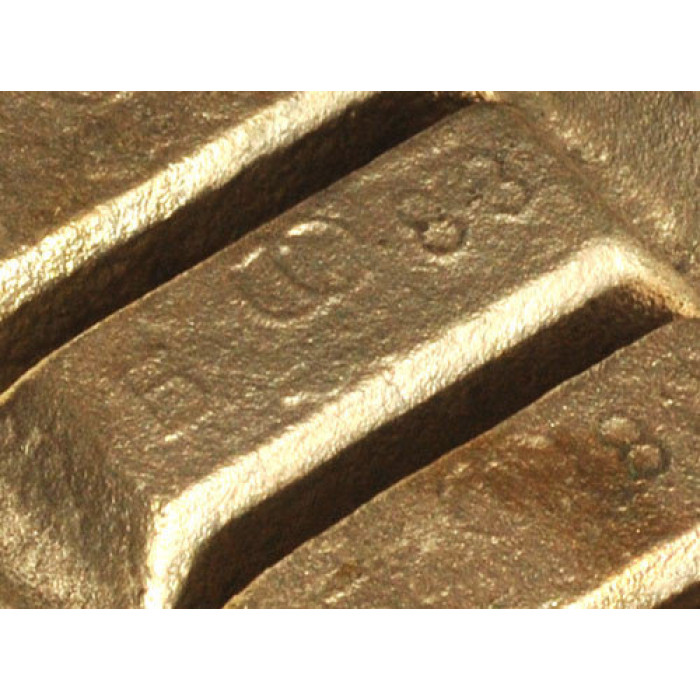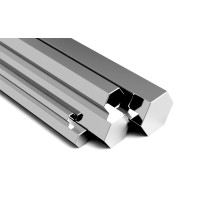Ishmael babbit B16, B83, tin O1, O1CH, solder POS40, POS61 delivery
Babbitt is a tin-based anti-friction casting alloy with the addition of copper, lead, antimony and other alloying components, intended for use as a layer of a plain bearing shell cast or sprayed over the body.
The babbitt structure is composed of small, hard metal crystals dispersed in softer metal, and is inherently a metal matrix composite material. As the bearing wears, the softer metal wears away, creating a soft lubricant between the protruding hard crystals that form the actual sliding surface. If the babbitt is based on tin, which is a soft matrix, then when rubbed without lubricant, the tin melts and acts as a lubricant, protecting the bearing from complete failure.
The melting point of most brands of babbits is 300-440 °C.
Babbit, which is based on tin, grades B88, B83, B83S (foreign brands SAE11, SAE12, ASTM2) are used when increased viscosity and a minimum coefficient of friction are required from an anti-friction material. Tin babbit compared to lead has a higher corrosion resistance, wear resistance and thermal conductivity.
Lead-based babbits - grades B16, BN, BSb, BKA, BK2, BK2Sh (foreign brands SAE13, SAE14, ASTM7, SAE15, ASTM15) - have a higher operating temperature than tin-based babbits. Lead-based babbits are used for diesel engine bearings, rolling mills.
Lead-calcium babbitt is used in rolling stock bearings of railway transport.
All babbits have a significant drawback - low fatigue resistance, which reduces the life of the bearing. Due to their low strength, babbits can only be successfully used in bearings with a strong steel (cast iron) or bronze housing. Typically, thin-walled bearing shells for automotive internal combustion engines are stamped from a bimetallic strip produced on a continuous casting line.
The life of the bearings depends on the thickness of the babbit layer cast on the steel bushing. Reducing the layer thickness increases the service life of the bearing.[specify]
Some brands of babbitt
Babbit (B83) is an alloy consisting of the following elements: Sn (83%); Sb (11%); Cu (6%) - for bearings operating under medium loads. Permissible working pressure [Pm]: 10-15 MPa.
Babbit (B16) is an alloy consisting of the following elements: Sn (15–17%); Sb (15-17%); Cu (1.5–2.0%); Pb (other) - for motor-axial bearings of electric locomotives, track machines, parts of steam locomotives and other heavy engineering equipment. Permissible working pressure [Pm]: 10 MPa.
Babbit (SOS6) is an alloy consisting of the following elements: Zn (5.5–6.5%); Sb (5.5–6.5%); Pb (rest) - designed for bearings operating at high loads (over 20 MPa) and temperatures over 300 degrees [source not specified 898 days], for bearings in automotive diesel engines.
The main brands of babbitt and their purpose
Babbit production is regulated by GOST 1320-74. Babbitt is formed into ingots designed to create an anti-friction layer and fill bearings, liners and other parts.
The marking is based on the chemical constituents of the alloy.
The most valuable from the point of view of recycling is B88 babbit, which contains 88% tin, antimony and nickel as alloying components, as well as cadmium and nickel. The use of this brand of babbitt is focused on mechanisms with turbine rotation (steam and diesel engines, turbocompressors).
B83 and B83C are also classified as rather expensive types of secondary raw materials. The composition contains about 83% tin, 12% antimony, about 6% copper. The letter "C" in the label indicates the presence of lead in the composition. The unique composition makes it possible to use B83S as a solid lubricant in working units where impact force acts.
Grade B16 has in its composition from 65 to 70% lead, the content of tin and antimony is the same (from 15 to 17%), and about 2% copper. The alloy is intended for casting bearings of water and railway transport, compressors, crushing plants and low power motors, steam turbines and mills of tube or ball type.
BN babbit contains about 10% tin, over 70% lead, and copper, cadmium, nickel, antimony or arsenic act as additional additives. Durable bearings are used for diesel compressors and generators.
The maximum amount (90%) of lead is present in BS6 grade babbitt. It is used in components and parts of tractor engines.
Modern production offers a large number of brands with various connection variations. Each additive changes the properties of the antifriction material.
Nickel has a positive effect on wear resistance.
Cadmium increases the resistance of the material to corrosion.
Copper increases toughness and hardness.
Antimony increases the strength of the alloy joint.
Have eachDoy grade material has its own scope of use. Of the technological characteristics, the most important is the melting temperature and the operating temperature, which allows the antifriction material to be poured into the bearing. In industrial production, babbit metal is produced from ore or secondary raw materials accepted for processing. It is produced in the form of ingots weighing 22 kg.
Babbits according to their composition can be divided into:
on lead;
for calcium;
on tin.
Lead babbits are based on lead-antimony alloys. Such a compound is called a eutectic. The scope of lead babbits can be called anti-friction treatment of bearings of internal combustion engines and rolling machines of metalworking enterprises. It can be used in railway transport.
Lead is also used in calcium grades of babbits, but alloys of this type are distinguished by the presence of a certain amount of calcium in the composition. Moreover, the following elements are added to the composition:
aluminum;
sodium;
tin.
The addition of these components can significantly reduce the cost of production of babbits without losing the main technical characteristics.
Tin babbits are distinguished by high resistance to corrosion and wear resistance. These alloys contain tin, copper and antimony, and lead or cadmium is also added to some types of tin babbits. Tin babbits are the most expensive among similar alloys, so scrapping them is the most profitable.
Such metal is not used to create jewelry, as it can be an allergen.
GOST Requirements According to the standards, a babbit of any group must: be made from primary or secondary metals, cast in an ingot weighing no more than 22 kg; to be smelted into ingots with a clean surface, without any kind of slag contamination. In the break of the ingot, the babbit, according to GOST, must be absolutely homogeneous. It is necessary to manufacture this alloy in workshops equipped with ventilation systems. According to the standards, the share of lead in the air of the working area at the enterprise should not exceed 0.01/0.005 mg/m3, antimony - 0.5/0.2 mg/m3.
The most important function of babbitt is its wear resistance, fusibility and density, all of which affect the overheating of bearings during operation. When buying ingots, it is also important to pay attention to the cleanliness of its surface, it is desirable that the babbit mark be on the ingot. All these unique properties of babbit allow it to still exist and be used in mechanics. Babbitt is an alloy based on tin, copper, lead and antimony are also added to it. In essence, babbitt is a composite material. In tin-based bearings, tin begins to melt without lubrication, forming a lubricant. Babbitt melts at a temperature of three hundred to four hundred and forty degrees Celsius. Tin-based babbitt has a number of undeniable advantages, such as: resistance to wear, corrosion and high thermal conductivity. The main disadvantage of babbitts is a very low fatigue resistance. They can not be used in all bearings. But only in those that have a durable cast iron housing. In production, babbitt is poured into pigs in the form of small ingots. It is produced from ore and secondary raw materials. Each pig has an approximate weight of twenty-two kilograms. During production, the presence of foreign impurities in the finished product is not allowed. The finished surface should be uniform and clean, without chips or breaks. This metal is not used for making jewelry because of its harmful effects in constant contact with the skin. According to safety regulations, babbitt is made in a carefully ventilated room. Babbitt has found wide application in the railway industry.
No questions about this product, be the first and ask your question.


